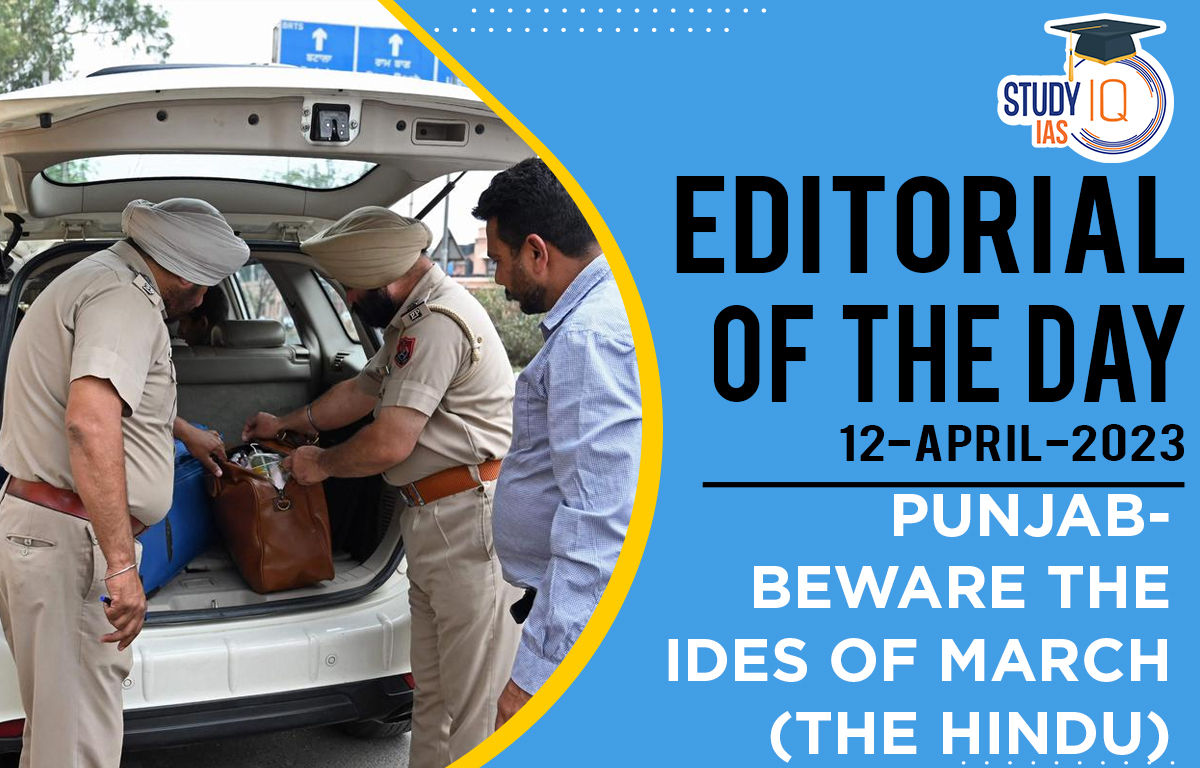Table of Contents
Context: The article is discussing the resurgence of Sikh extremism in areas outside India where a significant Sikh population is observed to reside. It notes that while sectarian violence has occurred in India before in different forms of Regionalism, the recent increase in Sikh extremism is attributed to the appearance of a new Sikh extremist preacher, Amritpal Singh, who is emulating a previous extremist leader-Bhindranwale, in demand for Khalistan. The article suggests that there are underlying causes for such a resurgence that need to be explored and addressed to prevent further violence both outside and in India.
Punjab-Beware the Ides of March Background
Regionalism: Regionalism is a political ideology that focuses on the interests of a particular region or group of regions, rather than the interests of an entire country.
Forms of Regionalism:
In India, regionalism has taken various forms, including secessionism, separatism, demands for full statehood, demands for autonomy, and demands for regional autonomy within a state.
- Secessionism:
- It is an extreme form of regionalism in which militant and fundamentalist groups advocate for the separation of a particular region from India on the basis of ethnicity or other factors.
- Examples of such groups include the National Socialist Council of Nagaland (NSCN-IM) led by Isac Muivah, Islamic fundamentalist groups in Jammu and Kashmir, and the United Liberation Front of Asom (ULFA) in Assam.
- Separatism:
- It involves demanding separate statehood within the Indian Union.
- This often occurs when linguistic or ethnic minorities within a state unite against the majority community.
- Examples of separatist movements include the formation of Khalistan, Uttarakhand, Jharkhand, Chhattisgarh, and Telangana.
- Demand for full statehood:
- This is another type of regional movement in which union territories demand to be recognized as full-fledged states within the Indian Union.
- This demand has already been accepted by several union territories, including Himachal Pradesh, Manipur, Tripura, Mizoram, Arunachal Pradesh, and Sikkim.
- Demand for autonomy:
- It involves the demand for more power and decision-making authority to be given to the states.
- This demand has been gaining strength due to central political interference.
- Several regional parties in states like Tamil Nadu, Punjab, Andhra Pradesh, and West Bengal have been demanding greater powers for their respective states.
- Demand for regional autonomy within a state involves recognizing the regional identities of various regions within a state.
- This demand is often fueled by regional imbalances resulting from inefficient planning.
- For example, Ladakhis in the erstwhile state of Jammu and Kashmir have demanded regional status to address their unique needs and concerns.
Causes of Regionalism:
- Historical and geographical isolation, insider-outsider complex that nurtures nativism and son-of-the-soil ideology.
- Uneven development, continuous neglect of a region and internal colonialism, despite being rich in natural resources some regions remain economically underdeveloped.
- Ill-conceived top-down approach for development or survival of one region at the cost of the other region.
- Imposition of an ideology that might be in conflict with the ideology that people of a particular have been possessing for a long time.
- Linguistic aspirations and expression of ethnicity have long remained a formidable basis of regionalism.
Impact of Regionalism in India:
The impacts of regionalism in India can be both positive and negative.
Positive Impacts:
- Preservation of local culture and identity: Regionalism helps to preserve the unique cultural and linguistic identities of different regions.
- Development of regions: When regions demand autonomy or separate statehood, it often leads to a focus on the development of that region. This can lead to the overall development of the region and an improvement in the standard of living of the people.
- Representation of local interests: Regionalism can ensure that the local interests of a particular region are represented and addressed by the central government.
Negative Impacts:
- Threat to national unity: One of the biggest negative impacts of regionalism is that it can pose a threat to national unity and integrity. This is particularly true when secessionist movements gain traction.
- Rise of extremist groups: Regionalism can also give rise to extremist groups that use violent means to achieve their goals. This can lead to political instability and social unrest.
- Impediment to economic growth: When regionalism leads to demands for separate statehood or autonomy, it can lead to the fragmentation of the country and create barriers to trade and commerce. This can impede economic growth and development.
- Discrimination against minorities: In some cases, regionalism can result in discrimination against minorities who may not belong to the dominant linguistic or cultural group in a particular region.
Khalistan- A Sikh Separatist Movement:
- The Khalistan movement is a Sikh separatist movement seeking to create a homeland for Sikhs by establishing a sovereign state, called Khalistan in the Punjab Region.
- The geographical area of the proposed state involves land that currently forms Indian Punjab, Chandigarh and some parts of the neighbouring Indian states, most particularly bordering Punjabi-speaking areas of Himachal Pradesh, Haryana and Rajasthan.
- Over the years, the movement has survived in various forms, in various places and amongst different populations.
- The movement was crushed in India following Operation Blue Star (1984) and Operation Black Thunder (1986 and 1988), but it continues to evoke sympathy and support among sections of the Sikh population, especially in the Sikh diaspora in countries such as Canada, the UK, and Australia.

Historical Events Responsible for Khalistan Movement
Before Independence
- The Singh Sabha Movement: It was founded at Amritsar in 1873 with a two-fold objective, to make available modern western education to the Sikhs, and to counter the proselytizing activities of Christian missionaries as well as the Brahmo Samajists, Arya Samajists, and Muslim maulvis.
- The Akali movement (also known as Gurudwara Reform Movement): It was an offshoot of the Singh Sabha Movement. It aimed at liberating the Sikh gurudwaras from the control of corrupt Udasi mahants.
- The above two movements have risen Sikh nationalism.
After Independence
- 1947 Partition of India: Partition left Sikhs in a lot of discontentment with regard to their traditional lands being lost to Pakistan and also a mass exodus of immigrants from Pakistan.
- Punjabi Suba movement: It was initiated in 1955 under Akali Dal, a Sikh dominated political party. It sought re-organization of Punjab along linguist lines, seeking division of the state into Punjabi and non-Punjabi speaking areas. After a series of violent protests movement resulted in the trifurcation of Punjab into Punjab, Haryana, and Himachal Pradesh.
- Anandpur Sahib Resolution: It reignited the passion of Sikhs and sowed the seeds of the Khalistan movement. The resolution demanded autonomy for the state of Punjab.
- All the above events have strengthened the claim of Khalistan.
Intensification of Movement
Although the above events have sown the seeds of Khalistan, the Khalistan movement was intensified by the following events:
- Jarnail Singh Bhindranwale: He travelled across Punjab advocating a return to the Khalsa or a more orthodox form of Sikhism.
- He was Inspired by the Khalistan ideology & led the Khalistan as an extremist movement (through violent protests and killings of high-profile persons in the Indian government) and turned against the Indian government.
- Operation Blue star (1984): It was conducted to capture Bhindrawale in Golden Temple Complex, but the operation resulted in a strong anti-India sentiment.
- The assassination of Indira Gandhi: The then PM Indira Gandhi was assassinated by her Sikh guards in 1984. Her killing was followed by wide-spread riots against the Sikhs in Delhi & other parts, the genocide of Sikhs across India fuelled more anti-India sentiment.
- Radicalization of youth: Manifold extremist groups like the Khalistan Liberation Force, Khalistan Commando Force, Babbar Khalsa, and others gained prominence and roamed around freely across Punjab. Which led to more polarization and radicalization of youth by these groups.
- Role of Pakistan: Pakistan’s ISI tried to foment the violence by providing support to extremist groups.
- Referendum 2020: Sikhs for Justice (SFJ) in its London Declaration has announced to hold the first-ever non-binding referendum among the global Sikh community with the goal of re-establishing Punjab as a nation-state.
Present Status of the Movement:
- At the present, Khalistan movement is a dormant movement in India.
- It does not hold much traction in the urban or local populace of Punjab.
- But the movement gets ideological support from Sikhs living in Canada, UK or USA.
- They pump money, ideological support to the struggle, ISI of Pakistan is still pumping money and effort in reviving the movement.
Decoding the Editorial
- Risk of Renewed Sikh Extremism/Sectarian Violence:
- The article is emphasizing that while the new self-styled Sikh extremist preacher, Amritpal Singh, may not have the substance of the previous extremist leader Bhindranwale, his attempts to emulate him are still having an impact on the extremist fringe of the Sikh youth, both within India and in the Sikh diaspora abroad.
- It notes that Bhindranwale’s inner circle still has connections with other pro-Khalistan groups, such as the Sikhs for Justice (SFJ), the Babbar Khasla, and the Khalistan Liberation Force (KLF).
- Thus, it would be a grave mistake to ignore the current situation, as there is a real risk of renewed Sikh extremism and sectarian violence.
- Memories of the past: The article notes that,
- India is a country with a diverse population that follows different religions, and that various groups within this population have at times expressed concern about being neglected or discriminated against.
- And that, the current situation in Punjab, where there is a resurgence of Sikh extremism, is particularly troubling due to the memories of the sectarian violence and political turmoil that occurred in the late 1970s to the 1990s, all of which culminated in the assassination of Prime Minister Indira Gandhi in 1984.
- Not Learning the Right Lesson from the past mistake:
- The article expresses concern that the current security measures in place in India have not learned from past mistakes in dealing with Sikh extremism.
- It states that the Bhindranwale phenomenon was not a sudden development, but a long-standing issue that could have been addressed and prevented from escalating into the violence and political turmoil that occurred in the 1980s.
- It suggests that for such events to not happen again in the future, preventing extremist leaders like Amritpal Singh from gaining momentum and support is the need of the hour.
- Also, it is more important to address the root causes of Sikh extremism and prevent it from escalating further, by effectively dealing with him and his supporters.
- Addressing the root cause of the problem via effective Intelligence Analysis:
- India must avoid jumping to conclusions about what caused the current Sikh extremism in India, specifically attributing it solely to a foreign conspiracy, such as the alleged involvement of Pakistan’s Inter-Services Intelligence (ISI) must be avoided.
- Because, such a narrow focus may prevent authorities from addressing the root causes of the problem, which may have deeper underpinnings.
- The article suggests that good intelligence is key to understanding the true nature and causes of such an issue.
- Effective Intelligence is coordinated Intelligence:
- The Indian Intelligence should be alerted to the rising discontent among sections of the Sikh youth and peasantry not only wrt the recent incident but also by past incidents like attack on a police station early this year.
- Intelligence agencies and authorities shall share this with friendly intelligence agencies abroad, especially in countries where the Sikh diaspora is present.
- Reduce Armed Tactics:
- India has to resist the temptation to resort to hard measures without understanding the root causes of extremist movements like Khalistan, and to avoid aligning with other nations that rely solely on strong-arm tactics.
- The author argues that India needs to find ways to defeat radical extremism of all kinds while maintaining a balance between the extremes of the right and left.
- The author stresses the importance of respecting individual dignity and promoting human progress, while also demonstrating leadership in the international community.
Beyond the Editorial
Measures to Tackle the growing Menace of Separatist Tendencies:
The Indian Government has taken several measures to tackle the growing menace of regionalism:
- Constitutional Provisions: The Constitution of India provides for a federal structure of governance, which ensures the representation of regional aspirations and interests. The formation of states on linguistic and cultural basis is also enshrined in the Constitution.
- Administrative Measures: The government has set up various bodies such as the Inter-State Council, which acts as a platform for discussion and resolution of inter-state issues. The government has also established special development packages for regions that are underdeveloped.
- Dialogue and Negotiations: The government has initiated dialogue and negotiations with various regional groups to understand their concerns and find amicable solutions.
- Security Measures: The government has taken strict security measures to deal with separatist and militant groups. The Armed Forces (Special Powers) Act, 1958 has been enforced in some regions to maintain law and order.
- Economic Development: The government has focused on economic development of regions to address the root causes of regionalism. Various schemes and programs have been launched to promote economic development in underdeveloped regions.
- Political Measures: The government has encouraged the formation of regional political parties to provide a platform for regional representation. The National Integration Council has also been set up to promote national integration and communal harmony.


 India’s First Full-Stack Quantum Compu...
India’s First Full-Stack Quantum Compu...
 World Liver Day 2025, Theme, History, Ce...
World Liver Day 2025, Theme, History, Ce...
 Kailash Mansarovar Yatra to Resume Soon,...
Kailash Mansarovar Yatra to Resume Soon,...





















